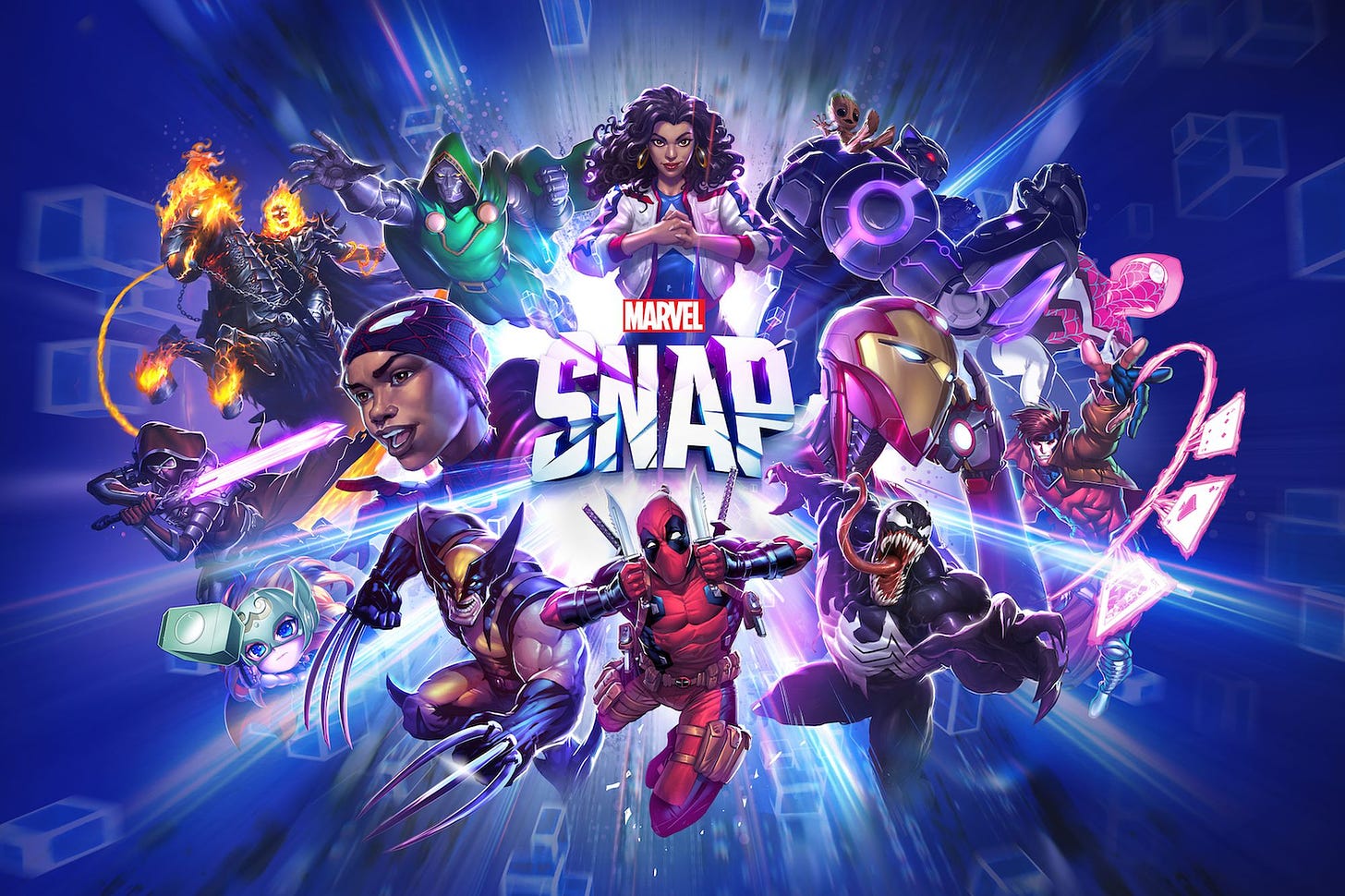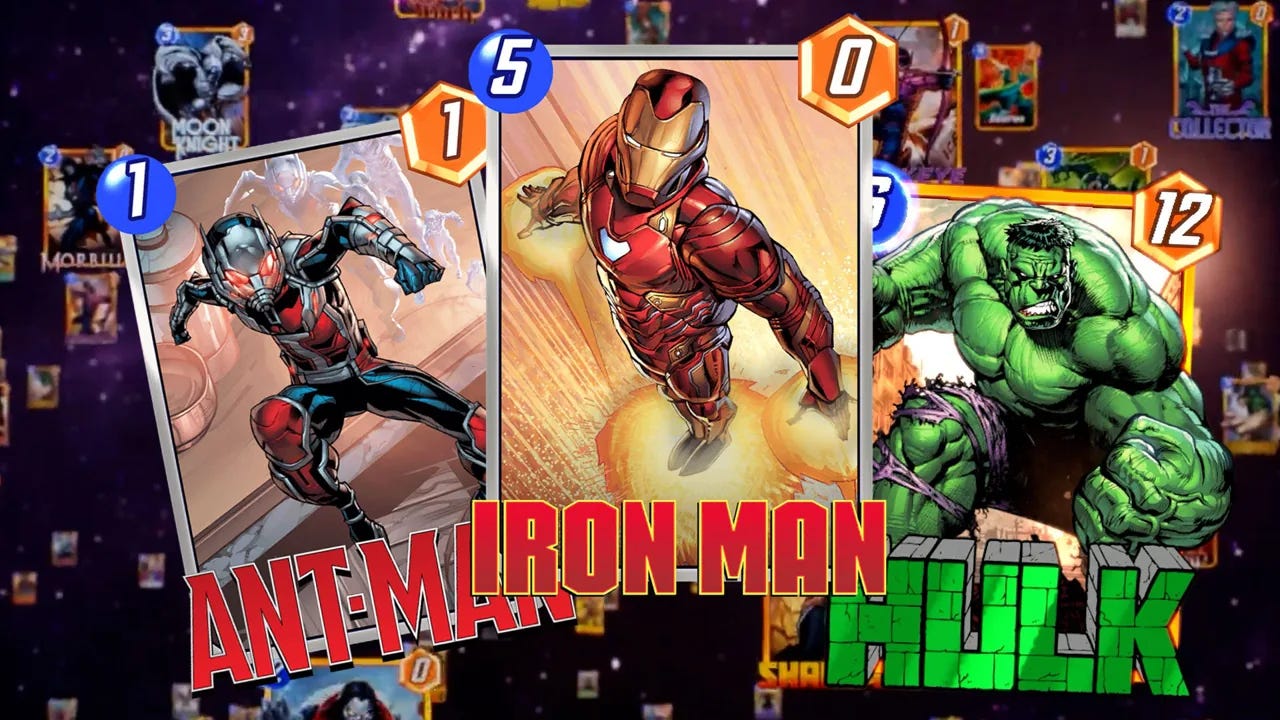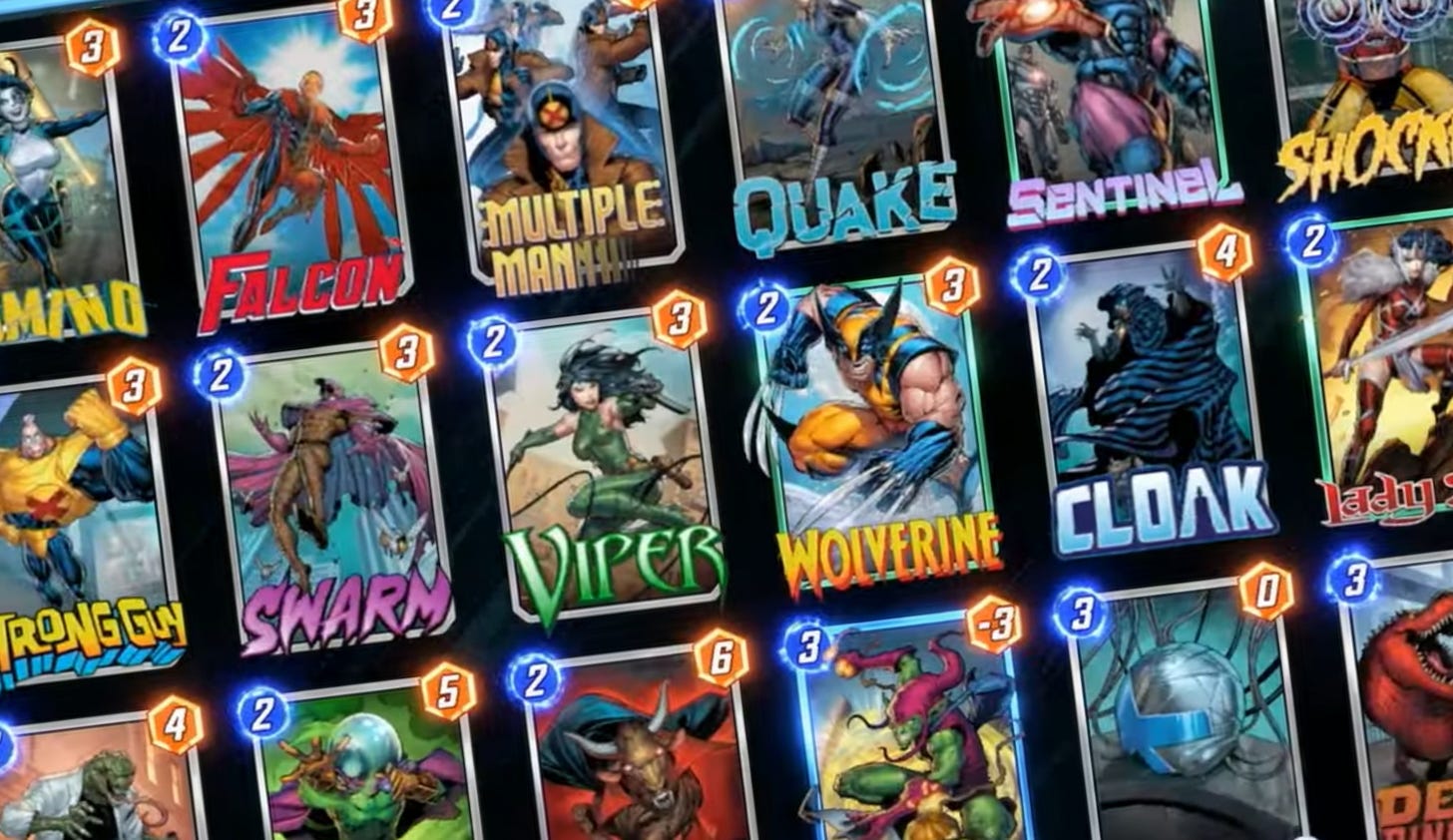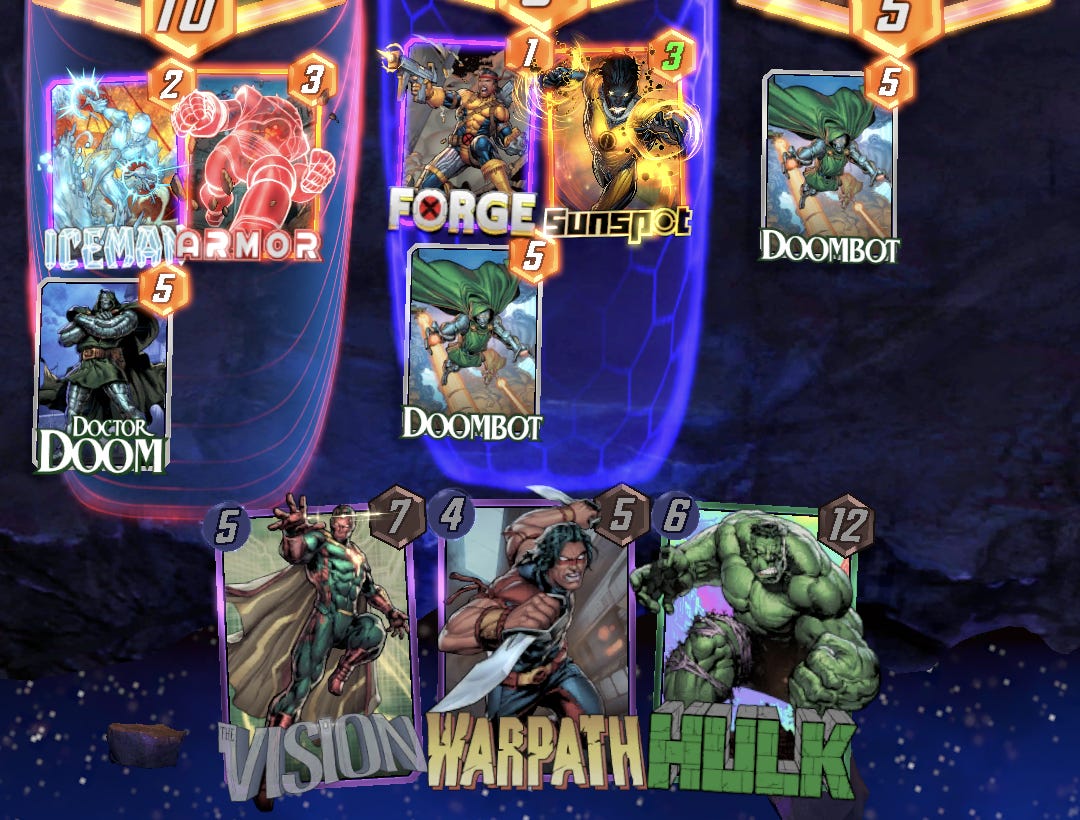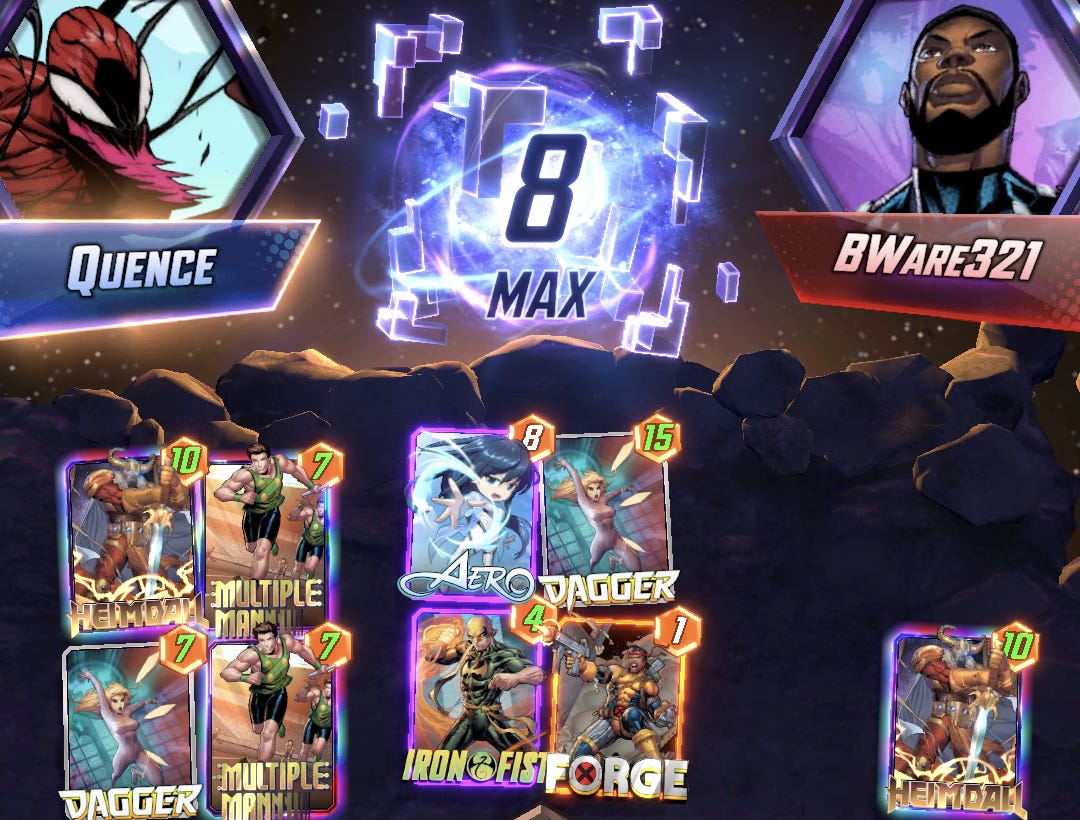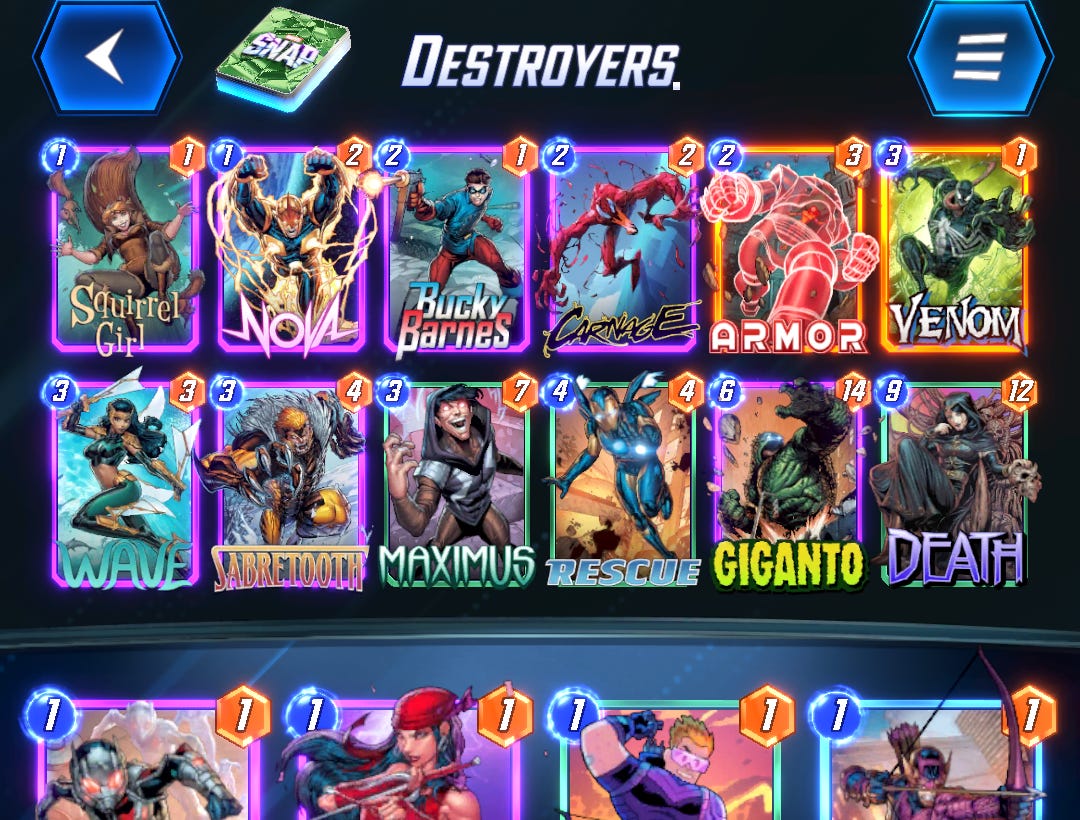I have never been a big fan of Collectible Card Games. Okay, when I was eleven, I was pretty into the Pokémon Trading Card Game, but I lost my love for the property as I got older. And sure, I’ve been dragged kicking and screaming into a few games of Magic: The Gathering, but it never drew me in the way it has so many others. Oh, and I guess I was ensnared by the digital Hearthstone for a short time, but eventually the trappings that I don’t care for got in the way of what separated it from the others. A more accurate title for this post might be “Marvel Snap Is The Only CCG I Actually Like”, but I didn’t think that was as catchy.
The closest I’ve come to enjoying CCGs as a “grown person” would be with their counterparts - Living Card Games, like Marvel Champions, which eliminate the “collectible” aspect of things entirely. Then there’s the “Unique Card Game” KeyForge, which I do love, but it’s really its own thing entirely, and I rarely get the chance to play it. I could write an entire post about what I don’t like in CCGs, but a better illustration of those points might come by way of comparison to a game that I do like.
That game is Marvel Snap, and it’s the newest digital card game in the ever burgeoning digital card game scene from Ben Brode, Hearthstone’s original director. Marvel Snap is a head-to-head card game, in which two players are vying for control of three different locations. Each card you play has an energy cost (a currency which you generate automatically each turn) and a power level (typically somewhere between 2 and 8). Whoever has the most power at a given location is the winner there. Win two out of three locations by the end of the game (usually six turns), and you’ve won the whole thing.
Since its release, I’ve been playing Marvel Snap on my phone daily, sometimes obsessively. I was playing it before I started writing this, and I’ll get a few more games in after I’ve finished (okay, I’ll probably take a break and play some in the middle too). Why has this [digital] CCG hooked me so effectively when virtually no other entry in the genre could?
Clever Implementation of Theme
If the name didn’t clue you in already, Marvel Snap is based on the Marvel Comics property, which happens to be one of my favorite things. (Please note that this preference makes me very special in our modern pop culture society.) Right off the bat, the use of this IP meant that I was more interested in trying this game out than if it had been made with say, a DC Comics skin, or some original sci-fi/fantasy universe. But it’s not as simple or as superficial as me just reacting to seeing characters I’m familiar with. Marvel Snap takes the characters of the Marvel universe and cleverly adapts them to cards that are fun to play while feeling perfectly tailored to who they’re based on.
A few examples:
Nightcrawler is a mutant with the power to teleport; his card has the ability to move to another location after it’s played.
Wolverine has regenerative healing powers; when his card is discarded or destroyed, it’s revived and reappears at a random location.
Invisible Woman (you know what her power is, right?) hides the cards you play at her location, keeping them unrevealed until the end of the game.
Hulk has no special ability, he’s just a simple card with a big power number attached to him. He smashes.
I could go on, because nearly every card in the game has some endearing trait like that that makes them a delight to play for anyone familiar with the character. Of course, there are some cards that could be considered more of a stretch (Iron Man doubles your power at a location because he… invented power doubling tech, I guess?), but more often than not I’m impressed by how authentic they feel to the powers and personalities of their inspirations. This isn’t a superfluous Marvel skin that was applied with haste for the sake of recognizability. It’s clear that the developers know what makes these characters special and how to best translate that to their game. As someone who cares a great deal about theme in games, this goes a very long way toward keeping me engaged.
A Straightforward, Engrossing Design
An obvious strength of Marvel Snap is how approachable it is. After a few short in-game tutorials, you’ll understand how the systems of energy and power work and be ready to play. Make your numbers bigger than your opponents’ numbers - that about sums it up. (Coming from the world of physical board games, there have been a few instances that made me wish for a long, dry rulebook to read through cover to cover, but I’m probably in the minority on that front.) It’s a simple setup, but of course it gets more complicated when you toss in individual card/location abilities and their potential interactions. By that time, you’re familiar enough with the basics that more advanced cards won’t scare you off.
How you play your cards is also refreshingly transparent. My absolute least favorite thing about traditional CCGs like Magic and Pokémon is their Mana systems, which force you to clog your deck with currency cards - it’s a boring, outdated game design that I was happy to see eliminated in Hearthstone and KeyForge. In Marvel Snap, energy is generated each turn in an amount equal to the turn number itself. This means that both players almost always have the same potential to play their cards. It feels fair, it’s consistent, and it allows you to focus on the cards you actually want to play instead of watering down your deck with filler.
Speed and Ease of Play
Maybe the biggest advantage of Marvel Snap over other CCGs is that it’s digital, and exists any time I want it on my phone. It’s dangerously accessible, and I tend to pick it up and play it any time I have a free minute. Two player tabletop games are notoriously difficult to get to the table for me and my gaming group. I’d love to play more KeyForge, but that means getting just one other person to the table (we tend to gather in groups of at least three) and of course, convincing them to play with me. With Marvel Snap, I never have to worry about finding someone else to play with, because someone is always just a click away thanks to the random matchmaking system.
If you do manage to convince a living, breathing person to play with you, a real life card game can drag on, and on… but Marvel Snap games are snappy (sorry). Because a game is only 6 turns long, you can play through one in mere minutes. Win or lose, it’ll be over before you know it, and then you’re back in for another one immediately after. It’s the epitome of the ‘just one more’ game - just one more so I can get my rank up; just one more so I can upgrade this card; just one more so I don’t end on a loss. Like I said, it’s dangerous.
A Relatively Even Playing Field
Naturally, some cards are stronger than others, but an aspect I love about Marvel Snap is that there’s always a potential counter to a winning strategy. Shang-Chi is a card that when played, destroys any enemy cards in his location with 9 or more power. This means that players banking on high power cards have to constantly stay on their toes in case Shang-Chi is waiting for them. Meanwhile, the Killmonger card destroys all 1-cost cards in play, stopping players from flooding the board with their little guys. I tend to use a deck that centers around destroying my own cards for various benefits - So when someone plays Armor, which prevents any cards from being destroyed at a location, it’s bad news for me.
There’s very much a rock-paper-scissors dynamic at play here. The Infinaut has 20 power and will frequently win a location by himself - but Shang-Chi can defeat him easily - unless Armor appears to protect The Infinaut… There’s always some way to take on even the strongest decks; it’s just a matter of which cards you have and whether or not you’ve prepared them.
Then, there are the locations, which have various effects on the match and appear randomly in each game. Sometimes these locations will greatly benefit one type of deck or the other. Often they’ll force you to completely re-think your strategy. Because of this, there’s really no such thing as an overpowered deck that will always win. Even a deck of the most powerful cards can lose to a newer player’s if the locations favor them. For some, this is a deterrent because it means you’re at the mercy of that monster called randomness. For me, it adds variety to the game, and ensures that matches aren’t overrun with the same meta decks over and over again.
The Snap
Every game of Marvel Snap has “cubes” on the line. Cubes determine your rank/level, which you’re rewarded for increasing. Win a standard game and you’ll win two cubes; lose and you’ll lose two cubes. Unless… there’s a snap. At any time during a match, you or your opponent can choose to “snap”, thereby doubling the amount of cubes at stake. If both players snap, you’ll be fighting over eight cubes total. It’s this game’s version of going all in if you think you’ve got a winning hand. On the flip side, if you think you’ve got a losing hand, you can retreat, the equivalent of folding, in order to save yourself from a potentially worse defeat.
This little mechanic might be the thing that really makes the game special. If either player snaps, the tension is greatly increased - but maybe your opponent is bluffing? Maybe you should bluff right back and hope to scare them off? Maybe your hand is so good that you don’t care how good they think theirs is? Eventually, you’ll get enough experience to be able to predict what your opponent has in hand, as well as whether or not you’ve got a fighting chance. Then, the game becomes less about the specific makeup of your deck, and more about how well you understand its strengths and weaknesses. It’s a subtle twist that really transforms the game into a playstyle that no other CCG really embraces.
Deck-building That Isn’t Overwhelming
One of the biggest deterrents to playing CCGs in real life for me is the amount of work required to get deep into them. Building a viable deck takes lots of time, money, and effort. My favorite thing about KeyForge is that I never have to build a deck at all. Marvel Champions’ deck-building is limited, but even within those limitations I get overwhelmed sometimes. I’m generally just not built for deck-building, but it’s never been easier than in Marvel Snap. Marvel Snap decks only have twelve cards, as opposed to most card games’ decks which tend to have around fifty. This is a much more digestible number of cards, and it’s super easy to throw a deck together in a minute or two.
Early on, there are a few very obvious deck archetypes which can be built simply by throwing a bunch of similar card types together. The game encourages making your own deck early on by keeping things simple before you try to discover more complex combinations. My initial attempts at deck-building only required me to filter my cards by certain keywords, and put everything I had of one card type together - and it worked! There are more interesting, complex deck possibilities that open up as your collection increases, but those early decks are often still viable in competitive play.
And once again, the game’s digital nature comes in handy, as it allows you to make as many decks as you like, using the same cards in multiple instances. No need for duplicates! No need for proxies! No need to keep a written list so you can disassemble and reassemble when needed! As someone who is really generally vehemently disinterested in deck-building of any kind, this is by far the friendliest, most approachable system I’ve encountered in a game like this.
As I’ve alluded to already, Marvel Snap is more a game of reading your opponent than having the best cards on the market, and in addition to all the other little quality of life features, that’s why I love it. It isn’t perfect - It’s currently missing some essential modes like unranked play and friend battles, and the longer you play, the harder it becomes to unlock new cards without paying. But it’s early days yet, and these are things that can (and in some ways already have) been addressed as time goes on.
The real question for me is whether or not this game will have staying power. Currently, I’m obsessed with it, but will I still be in a year’s time, or even in a few months? I’m not normally someone who dedicates himself to a game like this over a long period of time, but maybe this will be the one that finally hooks me. A lot also depends on how well the developers implement game updates, new cards, and special events. But even if I start to lose interest, the fact that Marvel Snap was able to draw me into a genre that I famously dislike is worth celebrating. Other game developers should take note - with the right tweaks and innovations, even a seemingly stale genre can find success in attracting new or lapsed players.
Okay, now I have to go, I just wanna get a few games in so I can complete today’s daily missions.



